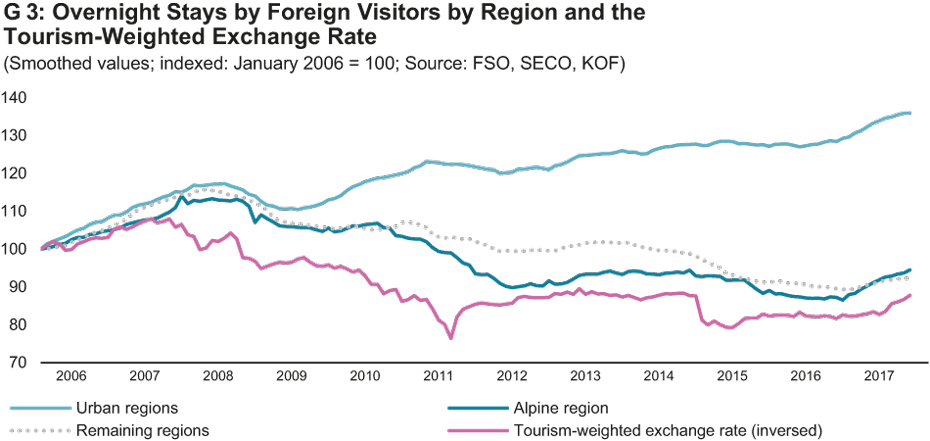Impact of the Exchange Rate on Swiss Tourism Regions
- KOF Tourism Forecast
- KOF Bulletin
The exchange rate between the CHF Swiss franc and other currencies plays a central role in terms of the development of Swiss tourism. However, a new study conducted by KOF shows that its impact varies significantly depending on the region.

Around 55% of overnight stays in Swiss hotels are booked by visitors from abroad. When the Swiss franc goes up, visits to Switzerland become more expensive for foreign travellers. Experience has shown that this has a negative effect on the number of overnight stays. However, the impact on hotel and catering businesses varies in the dif-ferent tourism regions. Graph 3 compares the trend in overnight stays in the various regions with the (inverse) tourism-weighted exchange rate index since 2005. The graph shows substantial differences between urban desti-nations, the Alpine region and the remaining tourist regions. After the financial crisis broke out in 2008, for instance, overnight stays by foreign visitors in the Alpine region declined substantially, reacting with a time lag to the steady increase in the value of the Swiss franc. This decline did not stop before the introduction of the minimum exchange rate by the Swiss National Bank in September 2011. In addition, the graph already shows the recovery of overnight stays in line with the Swiss franc’s slight devalu-ation since mid-2017.

By contrast, urban destinations followed a very different trend. The number of overnight stays by foreign visitors has remained relatively unaffected by the exchange rate, although the recent devaluation of the Swiss franc appears to be having an accelerating effect on the relatively strong growth in urban regions. In the remaining regions, the number of overnight stays followed a similar trend to the development in the Alpine region. However, the impact of exchange rate fluctuations appears to be slightly less pronounced.
Estimate of region-specific impact of the exchange rate
Empirical analysis of the effect of the exchange rate on Swiss municipalities, which was published last year, confirms the impression conveyed by Graph 3. According to the study, the response to fluctuations in the exchange rate shown by rural municipalities and municipalities depending on tourism is much more pronounced than that shown by city destinations. Based on the model underlying the study, our analysis provides estimates of the impact of fluctuations of the exchange rate on overnight stays in Switzerland’s 13 tourism regions. For our estimates, we utilise monthly data on overnight stays for the period January 2005 to February 2013, broken down according to tourism region as well as visitors’ country of origin. This degree of detail allows us to examine which of the various parameters may also affect the number of overnight stays.] The parameters consist of the income trend in the visitors’ countries of origin as well general region- and time-specific effects, for instance hotels’ price adjustments.

Substantial impact of the exchange rate on the Alpine region
Table T 1 presents the estimated coefficients and standard errors of the empirical analysis. The coefficients for the respective regions show the intensity of the response of foreign visitors’ overnight stays to a change in the value of the CHF Swiss franc (so-called exchange rate elasticity). The highest coefficient of 2 was estimated for Grisons. This means that overnight stays by foreign visitors to Grisons decline by 2% when the CHF Swiss franc gains 1% in value. Overnight stays also show a significant response to exchange rate fluctuations in Valais, Ticino and the Bern Region. In all three regions, a 1% appreciation of the CHF Swiss franc results in an around 1.8% decline in overnight stays by foreign visitors. By contrast, urban regions such as Basel, Geneva and Zurich show either no response or a very weak response to fluctuations in the exchange rate. Interestingly, our estimates of the coefficients for the Fribourg and Jura & Three Lakes regions are also statistically insignificant.
Variation in length of visits and reasons for visits
One of the main explanations for the different impact of the exchange rate on rural areas and cities may be the varying reasons for the visits. Business travellers, who predominantly stay in cities, may be less sensitive to prices than holiday makers. On top of this, the average length of visits in urban areas is significantly shorter than that of visits to Alpine regions. It makes more sense for tourists who come for longer visits to compare Swiss prices with those of foreign destinations. Moreover, tourism regions differ in regard of the structure of the visitors’ countries of origin. Tourists from long-distance markets, who often stay in urban destinations, tend to be less sensitive to the exchange rate than European guests, since expenditure in Switzerland accounts for a lower share of their total travel budget. In addition, Asian visitors frequently book their Swiss holiday in the context of a European trip and the CHF Swiss franc exchange rate is unlikely to have much influence on their decision to book such a trip.
[1] For the tourism-related exchange rate, see special analysis in KOF Forecasts for Swiss Tourism – October 2016.
[2] Stettler, C. (2017): How Do Overnight Stays React to Exchange Rate Changes? In: Schweizerische Zeitschrift für Volkswirtschaft und Statistik, 153(2), S. 123–165.
KOF Tourism Forecasts
The KOF Tourism Forecasts are prepared on behalf of the State Secretariat for Economic Affairs (SECO). SECO is in a position to finance tourism forecasts via the Swiss Federal Act on the promotion of innovation, cooperation and the expansion of expertise in the tourism sector (Innotour). The primary addressees of the tourism forecasts are the tourist sector and the cantons.